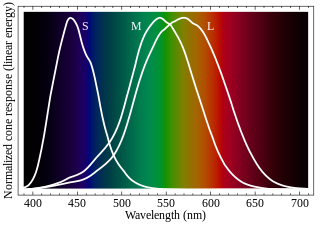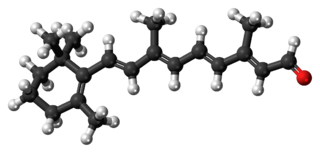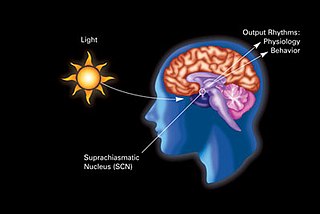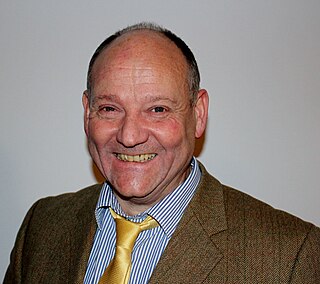Related Research Articles
Free-running sleep is a rare sleep pattern whereby the sleep schedule of a person shifts later every day. It occurs as the sleep disorder non-24-hour sleep-wake disorder or artificially as part of experiments used in the study of circadian and other rhythms in biology. Study subjects are shielded from all time cues, often by a constant light protocol, by a constant dark protocol or by the use of light/dark conditions to which the organism cannot entrain such as the ultrashort protocol of one hour dark and two hours light. Also, limited amounts of food may be made available at short intervals so as to avoid entrainment to mealtimes. Subjects are thus forced to live by their internal circadian "clocks".

The retina is the innermost, light-sensitive layer of tissue of the eye of most vertebrates and some molluscs. The optics of the eye create a focused two-dimensional image of the visual world on the retina, which then processes that image within the retina and sends nerve impulses along the optic nerve to the visual cortex to create visual perception. The retina serves a function which is in many ways analogous to that of the film or image sensor in a camera.

Chronobiology is a field of biology that examines timing processes, including periodic (cyclic) phenomena in living organisms, such as their adaptation to solar- and lunar-related rhythms. These cycles are known as biological rhythms. Chronobiology comes from the ancient Greek χρόνος, and biology, which pertains to the study, or science, of life. The related terms chronomics and chronome have been used in some cases to describe either the molecular mechanisms involved in chronobiological phenomena or the more quantitative aspects of chronobiology, particularly where comparison of cycles between organisms is required.

A photoreceptor cell is a specialized type of neuroepithelial cell found in the retina that is capable of visual phototransduction. The great biological importance of photoreceptors is that they convert light into signals that can stimulate biological processes. To be more specific, photoreceptor proteins in the cell absorb photons, triggering a change in the cell's membrane potential.

Cone cells, or cones, are photoreceptor cells in the retinas of vertebrate eyes including the human eye. They respond differently to light of different wavelengths, and the combination of their responses is responsible for color vision. Cones function best in relatively bright light, called the photopic region, as opposed to rod cells, which work better in dim light, or the scotopic region. Cone cells are densely packed in the fovea centralis, a 0.3 mm diameter rod-free area with very thin, densely packed cones which quickly reduce in number towards the periphery of the retina. Conversely, they are absent from the optic disc, contributing to the blind spot. There are about six to seven million cones in a human eye, with the highest concentration being towards the macula.

Retinal is a polyene chromophore. Retinal, bound to proteins called opsins, is the chemical basis of visual phototransduction, the light-detection stage of visual perception (vision).

Melanopsin is a type of photopigment belonging to a larger family of light-sensitive retinal proteins called opsins and encoded by the gene Opn4. In the mammalian retina, there are two additional categories of opsins, both involved in the formation of visual images: rhodopsin and photopsin in the rod and cone photoreceptor cells, respectively.

Giant retinal ganglion cells are photosensitive ganglion cells with large dendritic trees discovered in the human and macaque retina by Dacey et al. (2005).
Visual phototransduction is the sensory transduction process of the visual system by which light is detected to yield nerve impulses in the rod cells and cone cells in the retina of the eye in humans and other vertebrates. It relies on the visual cycle, a sequence of biochemical reactions in which a molecule of retinal bound to opsin undergoes photoisomerization, initiates a cascade that signals detection of the photon, and is indirectly restored to its photosensitive isomer for reuse. Phototransduction in some invertebrates such as fruit flies relies on similar processes.
Intrinsically photosensitive retinal ganglion cells (ipRGCs), also called photosensitive retinal ganglion cells (pRGC), or melanopsin-containing retinal ganglion cells (mRGCs), are a type of neuron in the retina of the mammalian eye. The presence of ipRGCs was first suspected in 1927 when rodless, coneless mice still responded to a light stimulus through pupil constriction, This implied that rods and cones are not the only light-sensitive neurons in the retina. Yet research on these cells did not advance until the 1980s. Recent research has shown that these retinal ganglion cells, unlike other retinal ganglion cells, are intrinsically photosensitive due to the presence of melanopsin, a light-sensitive protein. Therefore they constitute a third class of photoreceptors, in addition to rod and cone cells.

In neuroanatomy, the retinohypothalamic tract (RHT) is a photic neural input pathway involved in the circadian rhythms of mammals. The origin of the retinohypothalamic tract is the intrinsically photosensitive retinal ganglion cells (ipRGC), which contain the photopigment melanopsin. The axons of the ipRGCs belonging to the retinohypothalamic tract project directly, monosynaptically, to the suprachiasmatic nuclei (SCN) via the optic nerve and the optic chiasm. The suprachiasmatic nuclei receive and interpret information on environmental light, dark and day length, important in the entrainment of the "body clock". They can coordinate peripheral "clocks" and direct the pineal gland to secrete the hormone melatonin.
Photoreceptor proteins are light-sensitive proteins involved in the sensing and response to light in a variety of organisms. Some examples are rhodopsin in the photoreceptor cells of the vertebrate retina, phytochrome in plants, and bacteriorhodopsin and bacteriophytochromes in some bacteria. They mediate light responses as varied as visual perception, phototropism and phototaxis, as well as responses to light-dark cycles such as circadian rhythm and other photoperiodisms including control of flowering times in plants and mating seasons in animals.
The visual cycle is a process in the retina that replenishes the molecule retinal for its use in vision. Retinal is the chromophore of most visual opsins, meaning it captures the photons to begin the phototransduction cascade. When the proton is absorbed, the 11-cis retinal photoisomerizes into all-trans retinal as it is ejected from the opsin protein. Each molecule of retinal must travel from the photoreceptor cell to the RPE and back in order to be refreshed and combined with another opsin. This closed enzymatic pathway of 11-cis retinal is sometimes called Wald's visual cycle after George Wald (1906–1997), who received the Nobel Prize in 1967 for his work towards its discovery.
Light effects on circadian rhythm are the effects that light has on circadian rhythm.

Disc shedding is the process by which photoreceptor cells in the retina are renewed. The disc formations in the outer segment of photoreceptors, which contain the photosensitive opsins, are completely renewed every ten days.

Mammals normally have a pair of eyes. Although mammalian vision is not so excellent as bird vision, it is at least dichromatic for most of mammalian species, with certain families possessing a trichromatic color perception.

Russell Grant Foster, CBE, FRS FMedSci is a British professor of circadian neuroscience, the Director of the Nuffield Laboratory of Ophthalmology and the Head of the Sleep and Circadian Neuroscience Institute (SCNi). He is also a Nicholas Kurti Senior Fellow at Brasenose College at the University of Oxford. Foster and his group are credited with key contributions to the discovery of the non-rod, non-cone, photosensitive retinal ganglion cells (pRGCs) in the mammalian retina which provide input to the circadian rhythm system. He has written and co-authored over a hundred scientific publications.

King-Wai Yau is a Chinese-born American neuroscientist and Professor of Neuroscience at Johns Hopkins University School of Medicine in Baltimore, Maryland.
Samer Hattar is a chronobiologist and a leader in the field of non-image forming photoreception. He is the Chief of the Section on Light and Circadian Rhythms at the National Institute of Mental Health, part of the National Institutes of Health. He was previously an associate professor in the Department of Neuroscience and the Department of Biology at Johns Hopkins University in Baltimore, MD. He is best known for his investigation into the role of melanopsin and intrinsically photosensitive retinal ganglion cells (ipRGC) in the entrainment of circadian rhythms.
Steve A. Kay is a British-born chronobiologist who mainly works in the United States. Dr. Kay has pioneered methods to monitor daily gene expression in real time and characterized circadian gene expression in plants, flies and mammals. In 2014, Steve Kay celebrated 25 years of successful chronobiology research at the Kaylab 25 Symposium, joined by over one hundred researchers with whom he had collaborated with or mentored. Dr. Kay, a member of the National Academy of Sciences, U.S.A., briefly served as president of The Scripps Research Institute. and is currently a professor at the University of Southern California. He also served on the Life Sciences jury for the Infosys Prize in 2011.
References
- ↑ Provencio, Ignacio; Jiang, Guisen; De Grip, Willem J.; Hayes, William Pär; Rollag, Mark D. (1998). "Melanopsin: an opsin in melanophores, brain, and eye". Proceedings of the National Academy of Sciences. 95 (1): 340–5. Bibcode:1998PNAS...95..340P. doi: 10.1073/pnas.95.1.340 . PMC 18217 . PMID 9419377.
- ↑ "The Society for Research on Biological Rhythms". Society for Research on Biological Rhythms. Archived from the original on 22 March 2011. Retrieved 9 April 2011.
- ↑ Scientific American May 2011. . April 20, 2011.
- ↑ Provencio, Ignacio. "UVA Vision Research Group Directory". University of Virginia, Department of Ophthalmology. Retrieved 9 April 2011.
- ↑ "Ignacio Provencio". University of Virginia. Retrieved May 2, 2009.
- ↑ Provencio, I; Jiang, G; De Grip, WJ; Hayes, WP; Rollag, MD (1998). "Melanopsin: An opsin in melanophores, brain, and eye". Proc. Natl. Acad. Sci. USA. 95 (1): 340–5. Bibcode:1998PNAS...95..340P. doi: 10.1073/pnas.95.1.340 . PMC 18217 . PMID 9419377.
- ↑ Provencio, I; Rodriguez, IR; Jiang, G; Hayes, WP; Moreira, EF; Rollag, MD (2000). "A novel human opsin in the inner retina". The Journal of Neuroscience. 20 (2): 600–5. doi: 10.1523/jneurosci.20-02-00600.2000 . PMC 6772411 . PMID 10632589.
- 1 2 3 Panda, S.; Provencio, I; Tu, DC; Pires, SS; Rollag, MD; Castrucci, AM; Pletcher, MT; Sato, TK; et al. (2003). "Melanopsin is Required for Non-Image-Forming Photic Responses in Blind Mice". Science. 301 (5632): 525–7. Bibcode:2003Sci...301..525P. doi:10.1126/science.1086179. PMID 12829787. S2CID 37600812.
- 1 2 3 4 5 Panda, S.; Sato, TK; Castrucci, AM; Rollag, MD; Degrip, WJ; Hogenesch, JB; Provencio, I; Kay, SA (2002). "Melanopsin (Opn4) Requirement for Normal Light-Induced Circadian Phase Shifting". Science. 298 (5601): 2213–6. Bibcode:2002Sci...298.2213P. doi:10.1126/science.1076848. PMID 12481141. S2CID 20602808.
- 1 2 3 Göz, Didem; Studholme, Keith; Lappi, Douglas A.; Rollag, Mark D.; Provencio, Ignacio; Morin, Lawrence P. (2008). Greene, Ernest (ed.). "Targeted Destruction of Photosensitive Retinal Ganglion Cells with a Saporin Conjugate Alters the Effects of Light on Mouse Circadian Rhythms". PLOS ONE. 3 (9): e3153. Bibcode:2008PLoSO...3.3153G. doi: 10.1371/journal.pone.0003153 . PMC 2519834 . PMID 18773079.
- ↑ Czeisler, Charles A.; Shanahan, Theresa L.; Klerman, Elizabeth B.; Martens, Heinz; Brotman, Daniel J.; Emens, Jonathan S.; Klein, Torsten; Rizzo, Joseph F. (1995). "Suppression of Melatonin Secretion in Some Blind Patients by Exposure to Bright Light". New England Journal of Medicine. 332 (1): 6–11. doi:10.1056/NEJM199501053320102. PMID 7990870.
- ↑ "Circadian Rhythm Sleep Disorder (formerly Sleep-Wake Schedule Disorder)". Armenian Medical Network. Retrieved April 19, 2011.
- ↑ Baruch El-Ad MD. "Non-24-hour sleep-wake syndrome". Medlink Neurology. Retrieved April 19, 2011.
- ↑ Gooley, J. J.; Rajaratnam, S. M. W.; Brainard, G. C.; Kronauer, R. E.; Czeisler, C. A.; Lockley, S. W. (2010). "Spectral Responses of the Human Circadian System Depend on the Irradiance and Duration of Exposure to Light". Science Translational Medicine. 2 (31): 31ra33. doi:10.1126/scitranslmed.3000741. PMC 4414925 . PMID 20463367.
- 1 2 3 4 Gonzalez-Menendez, I.; Contreras, F.; Cernuda-Cernuda, R.; Provencio, I.; Garcia-Fernandez, J. M. (2010). "Postnatal Development and Functional Adaptations of the Melanopsin Photoreceptive System in the Albino Mouse Retina". Investigative Ophthalmology & Visual Science. 51 (9): 4840–4847. doi:10.1167/iovs.10-5253. PMC 2941179 . PMID 20435589.
- 1 2 3 Doyle, S. E.; Castrucci, A. M.; McCall, M.; Provencio, I.; Menaker, M. (2006). "Nonvisual light responses in the Rpe65 knockout mouse: Rod loss restores sensitivity to the melanopsin system". Proceedings of the National Academy of Sciences. 103 (27): 10432–10437. doi: 10.1073/pnas.0600934103 . PMC 1502475 . PMID 16788070.